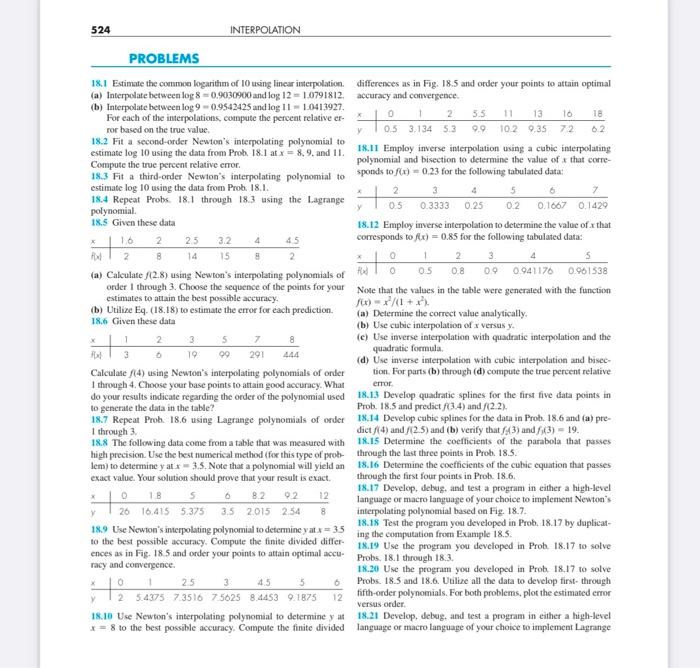.Use MATLAB to solve 18.17 p524 Write your name and ID inside the program code, or it will be considered .sheeting Submit both the source code and the .output 524 INTERPOLATION PROBLEMS y 18.1 Estimate the common logarithm of 10 using linear interpolation differences as in Fig. 18.5 and order your points to attain optimal (a) Interpolate between log 80.9030900 and log 12 - 1.0791812. accuracy and convergence. (b) Interpolate between log 9 -0.9542425 and log 111.0413927. 0 1 2 For each of the interpolations, compute the percent relative er 5.5 11 13 10 18 ror based on the true value. y 0.5 3.134 53 10.2 9.35 72 0.2 18.2 Fit a second-order Newton's interpolating polynomial to estimate log 10 using the data from Prob. 18.1 at x = 8.9. and 11. 18.11 Employ inverse interpolation using a cubic interpolating Compute the true percent relative crror polynomial and bisection to determine the value of that corre- 18.3 Fit a third-order Newton's interpolating polynomial to sponds to f(x) = 0,23 for the following tabulated data: estimate log 10 using the data from Prob. 18.1. 2 3 4 5 6 7 18.4 Repeat Probs. 18.1 through 18.3 using the Lagrange 0.5 0.3333 0.25 0.2 polynomial. 0.1667 0.1429 18.5 Given these data 18.12 Employ inverse interpolation to determine the value of x that 1.6 2 25 3.2 4 corresponds tox) = 0.85 for the following tabulated data: AN 2 14 15 8 2 1 4 5 (a) Calculate (2.8) using Newton's interpolating polynomials of 0 0.5 0.8 0.0 0.941176 0961538 order through 3. Choose the sequence of the points for your Note that the values in the table were generated with the function estimates to attain the best possible accuracy. (b) Utilize Eq. (18.18) to estimate the error for each prediction. f) - 2/(1+x) (a) Determine the correct value analytically, 18.6 Given these data (b) Use cubic interpolation of a versus y 1 2 5 7 8 (c) Use inverse interpolation with quadratic interpolation and the 3 19 09 291 444 quadratic formula (d) Use inverse interpolation with cubic interpolation and bisec Calculate 4) using Newton's interpolating polynomials of order tion. For parts (b) through (d) compute the true percent relative through 4. Choose your base points to attain good accuracy. What error do your results indicate regarding the order of the polynomial used 18.13 Develop quadratic splines for the first five data points in to generate the data in the table? Prob. 18.5 and predict (3.4) and (22) 18.7 Repeat Prob. 186 using Lagrange polynomials of order 18.14 Develop cubic splines for the data in Prob. 18.6 and (a) pre- 1 through 3 dict (4) and (2.5) and (b) verify that 43) and (3) = 19. 18.8 The following data come from a table that was measured with 18.15 Determine the coefficients of the parabola that passes high precision. Use the best numerical method for this type of prob through the last three points in Prob. 18.5. lem) to determine y atx 3.5. Note that a polynomial will yield an 18.16 Determine the coefficients of the cubic equation that passes exact value. Your solution should prove that your result is exact through the first four points in Prob. 18.6. * 018 18.17 Develop, debug, and test a program in either a high-level 5 6 8.2 0212 language or macro language of your choice to implement Newton's 26 16,415 5.375 35 2015 2.548 interpolating polynomial based on Fig. 18.7. 189 Use Newton's interpolating polynomial to determine yatx=35 18.18 Test the program you developed in Prob. 18.17 by duplicat- ing the computation from Example 18.5. to the best possible accuracy. Compute the finite divided differ ences as in Fig. 18.5 and order your points to attain optimal accu 18.19 Use the program you developed in Prob. 18.17 to solve racy and convergence Probs. 18.1 through 18.3. 18.20 Use the program you developed in Prob. 18.17 to solve 0 1 25 3 4.5 5 6 Probs. 18.5 and 18.6. Utilize all the data to develop first through Y 25.4375 73516 7.5625 8.4453 9.1875 12 fifth-order polynomials. For both problems, plot the estimated error versus order 18.10 Use Newton's interpolating polynomial to determine y at 18.21 Develop, debug, and test a program in either a high-level x = 8 to the best possible accuracy, Compute the finite divided language or macro language of your choice to implement Lagrange








